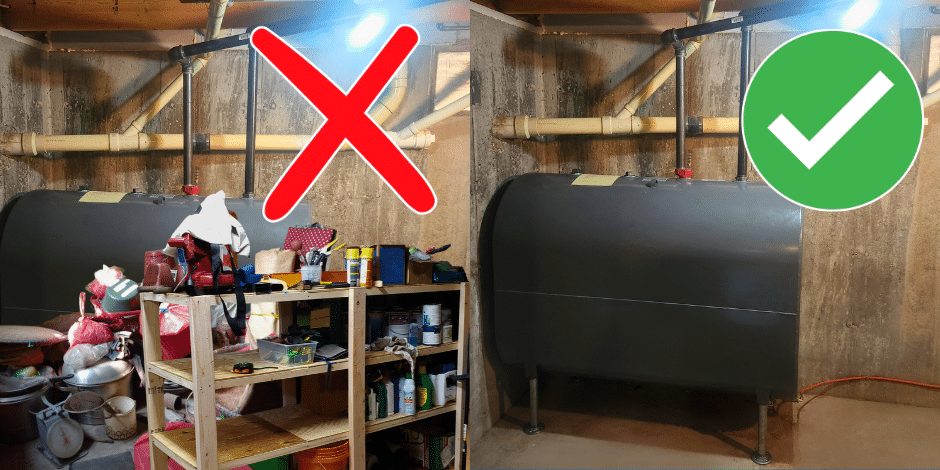To comply with Vermont’s aboveground storage tank (AST) regulations, homeowners must have their heating oil tanks inspected regularly. The inspection ensures that your tank meets state safety and environmental standards, focusing on structural integrity, proper installation, and correct piping. These regulations were recently updated as of August 1, 2024, and could differ from the standards applied during your last inspection. The changes include stricter criteria for tank installation, condition, and associated piping. Inspectors will also assess tanks based on the new yellow-tagging system, where non-compliant tanks are tagged for necessary upgrades or replacement.
Staying informed about these changes ensures that your oil tank remains compliant and helps you avoid service delays.
What are the new requirements for an oil tank inspection in Vermont?
- Foundation Requirements: All new tanks must be installed on a concrete foundation at least 4 inches deep and 10% larger than the tank’s dimensions. Existing tanks must meet this requirement by 2030.
- Piping and Fuel Lines: Pipes in contact with earth or concrete must now be coated and sleeved to prevent corrosion and crushing.
- Yellow Tag System: Introduced to allow conditional use of non-compliant tanks with lower risks until May 1 of the heating season. Yellow-tagged tanks must meet specific criteria, and once the tag expires, it becomes a red tag, prohibiting fuel delivery.
- Red Tag Updates: New items have been added to the red tag criteria, including the requirement for all unused ports to be plugged and fill/vent pipes to be made of metallic materials.
- Checklists: New checklists have been introduced for tanks installed before and after August 1, 2024. Inspection results for an existing customer are valid for four years from the last inspection date, unless otherwise noted, except if the owner changes suppliers. The tank must be inspected under the new rules before the first delivery.
How can I prepare for my oil tank inspection or fuel delivery?
We will call you 1-3 days before we are in your area for a delivery or required inspection. We ask that you keep the area around your oil tank free and clear of debris or other items, unlock any doors necessary for access, and keep animals in a separate area of the home while we deliver your oil or inspect your tank. A clear path to your oil tank is necessary as our team needs to look above, below, and on all sides of the tank to ensure a thorough inspection.
If we cannot access your tank, we will notify you and call to reschedule the inspection or delivery. It is important to have your tank accessible, especially in winter months. If there isn’t a clear path to your tank and we are unable to fill or inspect it, the next time we are in your area might not be for an additional 7-10 days which means if your tank is low you may run out or incur extra fees if you request an “off route/special trip” delivery.

What should I do if my tank is Yellow Tagged?
If your oil tank or lines are yellow tagged, it means there’s an issue that needs to be addressed. You’ll be given a specific deadline by which the problem must be corrected to continue oil deliveries. Until then, continuing to fuel the tank is at the discretion of the driver. Depending on the condition of the tank, the driver may decide to deliver a minimal amount. It’s essential to take the yellow tag seriously and ensure the necessary repairs or adjustments are made before the deadline. Addressing the issue promptly will help prevent it from escalating into a more severe problem that could result in a red tag, potentially leaving you without heating fuel until the situation is resolved.
What should I do if my tank is Red Tagged?
If your oil tank has been red tagged, it means there’s a serious safety issue that needs immediate attention. Depending on the severity of the problem, a delivery driver may exercise discretion in delivering a small amount of fuel. However, if the issues with the tank present a significant risk, the driver won’t be able to add any fuel. It’s important to note that we, along with other reputable companies, will not fill a red-tagged tank until the issue is resolved. Filling a tank that’s been red tagged can lead to fines, and more importantly, it compromises safety. Therefore, if your tank is red tagged, you should schedule repairs or replacements as soon as possible to ensure your heating system is safe and operational.
Replacing an oil tank can be a costly and stressful endeavor for many households, but the safety of your family and the environment depends on keeping your tank in good shape. We’re committed to helping you navigate these challenges and ensuring that your home heating system remains reliable and compliant with state regulations. If you’re looking to apply for a grant for the cost of your oil tank replacement, there are options through the State of Vermont. If you have any questions on how the Co-op can help get your existing tank up to compliance or guide you through a replacement, contact us today.








